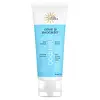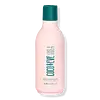What's inside
What's inside
 Key Ingredients
Key Ingredients

No key ingredients
 Benefits
Benefits

 Concerns
Concerns

 Ingredients Side-by-side
Ingredients Side-by-side

Water
Skin ConditioningSodium Cocoyl Isethionate
CleansingCocamidopropyl Betaine
CleansingSodium Methyl Cocoyl Taurate
CleansingCocamidopropyl Hydroxysultaine
CleansingGlycerin
HumectantArgania Spinosa Kernel Oil
EmollientButyrospermum Parkii Butter
Skin ConditioningCocos Nucifera Oil
MaskingAloe Barbadensis Leaf Juice
Skin ConditioningHydrolyzed Silk
HumectantPersea Gratissima Oil
Skin ConditioningOlea Europaea Fruit Oil
MaskingGlyceryl Caprylate
EmollientGlyceryl Undecylenate
EmollientGlycol Distearate
EmollientPotassium Sorbate
PreservativeHydroxyethylcellulose
Emulsion StabilisingCitric Acid
BufferingParfum
MaskingWater, Sodium Cocoyl Isethionate, Cocamidopropyl Betaine, Sodium Methyl Cocoyl Taurate, Cocamidopropyl Hydroxysultaine, Glycerin, Argania Spinosa Kernel Oil, Butyrospermum Parkii Butter, Cocos Nucifera Oil, Aloe Barbadensis Leaf Juice, Hydrolyzed Silk, Persea Gratissima Oil, Olea Europaea Fruit Oil, Glyceryl Caprylate, Glyceryl Undecylenate, Glycol Distearate, Potassium Sorbate, Hydroxyethylcellulose, Citric Acid, Parfum
Water
Skin ConditioningSodium C14-16 Olefin Sulfonate
CleansingSodium Methyl Cocoyl Taurate
CleansingCetyl Betaine
CleansingSodium Cocoamphoacetate
CleansingLauryl Glucoside
CleansingGlycerin
HumectantCocos Nucifera Oil
MaskingAnanas Sativus Fruit Extract
Skin ConditioningNephelium Lappaceum Branch/Fruit/Leaf Extract
Skin ConditioningHydrolyzed Hyaluronic Acid
HumectantArgania Spinosa Kernel Oil
EmollientFicus Carica Fruit Extract
HumectantPersea Gratissima Oil
Skin ConditioningHydrolyzed Pea Protein
EmollientSapindus Trifoliatus Fruit Extract
Skin ConditioningSodium Hyaluronate
HumectantCocos Nucifera Fruit Juice
EmollientCocos Nucifera Water
MaskingPsidium Guajava Fruit Extract
AstringentPhospholipids
Skin ConditioningGlycol Distearate
EmollientPolyquaternium-22
Sodium Cocoyl Glutamate
CleansingSodium Lauryl Glucose Carboxylate
CleansingSodium Stearoyl Lactylate
EmulsifyingGlyceryl Caprylate
EmollientGlyceryl Stearate
EmollientPropanediol
SolventCetearyl Alcohol
EmollientTetrasodium Glutamate Diacetate
Glyceryl Undecylenate
EmollientPolyglyceryl-10 Dioleate
EmulsifyingPolyglyceryl-10 Oleate
Skin ConditioningGuar Hydroxypropyltrimonium Chloride
Skin ConditioningCocamidopropyl Betaine
CleansingLaureth-4
EmulsifyingAcrylates/C10-30 Alkyl Acrylate Crosspolymer
Emulsion StabilisingSodium Benzoate
MaskingPotassium Sorbate
PreservativeParfum
MaskingBenzyl Salicylate
PerfumingCoumarin
PerfumingLinalool
PerfumingCitric Acid
BufferingWater, Sodium C14-16 Olefin Sulfonate, Sodium Methyl Cocoyl Taurate, Cetyl Betaine, Sodium Cocoamphoacetate, Lauryl Glucoside, Glycerin, Cocos Nucifera Oil, Ananas Sativus Fruit Extract, Nephelium Lappaceum Branch/Fruit/Leaf Extract, Hydrolyzed Hyaluronic Acid, Argania Spinosa Kernel Oil, Ficus Carica Fruit Extract, Persea Gratissima Oil, Hydrolyzed Pea Protein, Sapindus Trifoliatus Fruit Extract, Sodium Hyaluronate, Cocos Nucifera Fruit Juice, Cocos Nucifera Water, Psidium Guajava Fruit Extract, Phospholipids, Glycol Distearate, Polyquaternium-22, Sodium Cocoyl Glutamate, Sodium Lauryl Glucose Carboxylate, Sodium Stearoyl Lactylate, Glyceryl Caprylate, Glyceryl Stearate, Propanediol, Cetearyl Alcohol, Tetrasodium Glutamate Diacetate, Glyceryl Undecylenate, Polyglyceryl-10 Dioleate, Polyglyceryl-10 Oleate, Guar Hydroxypropyltrimonium Chloride, Cocamidopropyl Betaine, Laureth-4, Acrylates/C10-30 Alkyl Acrylate Crosspolymer, Sodium Benzoate, Potassium Sorbate, Parfum, Benzyl Salicylate, Coumarin, Linalool, Citric Acid
 Reviews
Reviews

Ingredients Explained
These ingredients are found in both products.
Ingredients higher up in an ingredient list are typically present in a larger amount.
You may know this ingredient as argan oil. Argan Oil has antioxidant, hydrating, and soothing properties.
Studies have shown argan oil can help fight again radical damage from the sun. This makes it effective at preventing hyperpigmentation.
Large amounts of vitamin E found in argan oil helps the skin retain water. Argan oil also contains fatty acids such as linoleic acid, oleic acid, and palmitic acid. It is also a good source of lipids.
Another benefit of argan oil is skin-soothing. It can help reduce inflammation-related skin symptoms.
Argan Oil is effective at regulating sebum production in pores. This can make it effective at treating hormonal acne.
Traditionally, argan oil was used for its antibacterial and antifungal properties. However, argan oil contains fatty acids that may make it not fungal-acne safe.
Argan Trees are native to Morocco.
Learn more about Argania Spinosa Kernel OilCitric Acid is an alpha hydroxy acid (AHA) naturally found in citrus fruits like oranges, lemons, and limes.
Like other AHAs, citric acid can exfoliate skin by breaking down the bonds that hold dead skin cells together. This helps reveal smoother and brighter skin underneath.
However, this exfoliating effect only happens at high concentrations (20%) which can be hard to find in cosmetic products.
Due to this, citric acid is usually included in small amounts as a pH adjuster. This helps keep products slightly more acidic and compatible with skin's natural pH.
In skincare formulas, citric acid can:
While it can provide some skin benefits, research shows lactic acid and glycolic acid are generally more effective and less irritating exfoliants.
Most citric acid used in skincare today is made by fermenting sugars (usually from molasses). This synthetic version is identical to the natural citrus form but easier to stabilize and use in formulations.
Read more about some other popular AHA's here:
Learn more about Citric AcidCocamidopropyl Betaine is a fatty acid created by mixing similar compounds in coconut oil and dimethylaminopropylamine, a compound with two amino groups.
This ingredient is a surfactant and cleanser. It helps gather the dirt, pollutants, and other impurities in your skin to be washed away. It also helps thicken a product and make the texture more creamy.
Being created from coconut oil means Cocamidopropyl Betaine is hydrating for the skin.
While Cocamidopropyl Betaine was believed to be an allergen, a study from 2012 disproved this. It found two compounds in unpure Cocamidopropyl Betaine to be the irritants: aminoamide and 3-dimethylaminopropylamine. High-grade and pure Cocamidopropyl Betaine did not induce allergic reactions during this study.
Learn more about Cocamidopropyl BetaineCocos Nucifera Oil is obtained from the kernels of the coconut fruit. In other words, this is coconut oil.
Coconut Oil is rich in fatty acids with lauric acid making up the majority of these. It also contains linoleic acid. Due to this high fatty acid content, coconut oil helps trap moisture and soften skin.
Despite being antibacterial, coconut oil may not be great for acne-prone skin. It is comedogenic and may clog pores. This ingredient may not be safe for malassezia or fungal acne.
Note: Coconut Oil should not replace your sunscreen for UV protection. Studies show it only blocks about 20% of UV.
This oil is non-volatile and has a light scent.
The term 'fragrance' is not regulated in many countries. In many cases, it is up to the brand to define this term. For instance, many brands choose to label themselves as "fragrance-free" because they are not using synthetic fragrances. However, their products may still contain ingredients such as essential oils that are considered a fragrance.
Learn more about Cocos Nucifera OilGlycerin is already naturally found in your skin. It helps moisturize and protect your skin.
A study from 2016 found glycerin to be more effective as a humectant than AHAs and hyaluronic acid.
As a humectant, it helps the skin stay hydrated by pulling moisture to your skin. The low molecular weight of glycerin allows it to pull moisture into the deeper layers of your skin.
Hydrated skin improves your skin barrier; Your skin barrier helps protect against irritants and bacteria.
Glycerin has also been found to have antimicrobial and antiviral properties. Due to these properties, glycerin is often used in wound and burn treatments.
In cosmetics, glycerin is usually derived from plants such as soybean or palm. However, it can also be sourced from animals, such as tallow or animal fat.
This ingredient is organic, colorless, odorless, and non-toxic.
Glycerin is the name for this ingredient in American English. British English uses Glycerol/Glycerine.
Learn more about GlycerinGlyceryl Caprylate comes from glycerin and caprylic acid, a fatty acid from coconut. It has emollient and emulsifier properties.
As an emollient, it helps hydrate your skin. Emollients work by creating a barrier on your skin to trap moisture in, helping to keep your skin soft and smooth.
On the other hand, emulsifiers prevent ingredients (such as oil and water) from separating.
Learn more about Glyceryl CaprylateThis ingredient is an emollient and emulsifier.
Due to its thick oil / waxy texture, it has emollient properties. Emollients help hydrate skin by creating a thin film. This film prevents moisture from escaping.
Glyceryl Undecylenate is created from glycerin and undecylenic acid.
Undecylenic Acid is a fungal treatment, but is not as effective as newer medications.
Some people who have sensitive skin may find this ingredient to trigger Malassezia folliculitis, but not everyone will react to it.
Learn more about Glyceryl UndecylenateGlycol Distearate serves as a pearlizing or opacifying agent in cosmetic products.
It's often included in cleansers and haircare products to give them a lustrous or shimmering appearance.
It is derived from stearic acid, a natural fatty acid commonly found in vegetable oils and animal fats.
Glycol Distearate isn't fungal acne safe.
Learn more about Glycol DistearateParfum is a catch-all term for an ingredient or more that is used to give a scent to products.
Also called "fragrance", this ingredient can be a blend of hundreds of chemicals or plant oils. This means every product with "fragrance" or "parfum" in the ingredients list is a different mixture.
For instance, Habanolide is a proprietary trade name for a specific aroma chemical. When used as a fragrance ingredient in cosmetics, most aroma chemicals fall under the broad labeling category of “FRAGRANCE” or “PARFUM” according to EU and US regulations.
The term 'parfum' or 'fragrance' is not regulated in many countries. In many cases, it is up to the brand to define this term.
For instance, many brands choose to label themselves as "fragrance-free" because they are not using synthetic fragrances. However, their products may still contain ingredients such as essential oils that are considered a fragrance by INCI standards.
One example is Calendula flower extract. Calendula is an essential oil that still imparts a scent or 'fragrance'.
Depending on the blend, the ingredients in the mixture can cause allergies and sensitivities on the skin. Some ingredients that are known EU allergens include linalool and citronellol.
Parfum can also be used to mask or cover an unpleasant scent.
The bottom line is: not all fragrances/parfum/ingredients are created equally. If you are worried about fragrances, we recommend taking a closer look at an ingredient. And of course, we always recommend speaking with a professional.
Learn more about ParfumPersea Gratissima Oil is also known as avocado oil.
Avocado Oil has antioxidant properties. It is mostly made up of the glycerides of fatty acids. About 67% of these fatty acids is made up of oleic acid. Palmitic acid and linoleic acid are also present.
These fatty acids help hydrate and soften the skin. It may increase collagen content in the skin. Collagen helps keep your skin plump and firm. This ingredient helps reduce inflammation and has not shown to clog pores.
This ingredient may not be fungal-acne safe due to its high fatty acid content.
Avocados also have B vitamins, vitamin K, vitamin C, vitamin E, and potassium.
Learn more about Persea Gratissima OilPotassium Sorbate is a preservative used to prevent yeast and mold in products. It is commonly found in both cosmetic and food products.
This ingredient comes from potassium salt derived from sorbic acid. Sorbic acid is a natural antibiotic and effective against fungus.
Both potassium sorbate and sorbic acid can be found in baked goods, cheeses, dried meats, dried fruit, ice cream, pickles, wine, yogurt, and more.
You'll often find this ingredient used with other preservatives.
Learn more about Potassium SorbateThis gentle cleansing and foaming ingredient is known for leaving a smooth feeling in skin and hair. It is made using coconut oil.
According to the manufacturer, it is soluble in water and has resistance to hard water, acid, and alkali.
Due to its coconut base, it may not be Malassezia folliculitis safe.
Learn more about Sodium Methyl Cocoyl TaurateWater. It's the most common cosmetic ingredient of all. You'll usually see it at the top of ingredient lists, meaning that it makes up the largest part of the product.
So why is it so popular? Water most often acts as a solvent - this means that it helps dissolve other ingredients into the formulation.
You'll also recognize water as that liquid we all need to stay alive. If you see this, drink a glass of water. Stay hydrated!
Learn more about Water